#1909 september
Photo

1914 Photographed in Autochrome Lumière by Auguste Louis, First air show, Grand Palais, Paris, France. Art Nouveau.
First color photos autochrome Lumiere by Auguste Louis, Hot air balloons in Paris 1914.
#1914#historic photo#autochrome lumière#1909 september#art nouveau#la belle epoque#autochrome#grand palais#paris#Grand Palais paris#1910s paris#michelin#air balloon#auguste louis#1914 paris#1910s lifestyle#hot air balloons#lumière
996 notes
·
View notes
Text
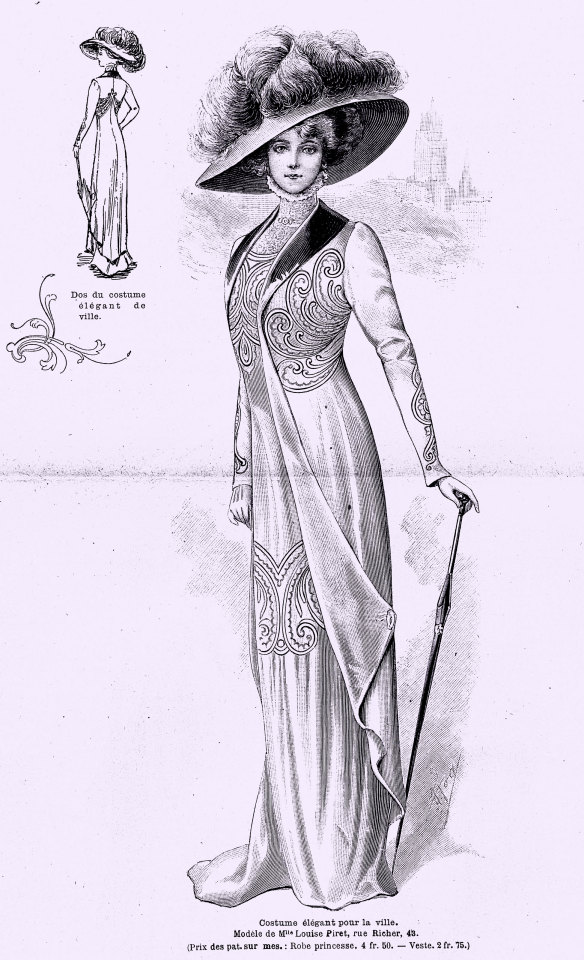
La Mode illustrée, no. 38, 19 septembre 1909, Paris. Costume élégant pour la ville. Modèle de Mlle Louise Piret, rue Richer, 43. Ville de Paris / Bibliothèque Forney
Ce costume se compose d'une robe princesse et d'un paletot très long; on l'exécute en drap satin nuance aubergine très clair, et on le garnit de broderie d'une teinte plus foncée. Le grand col-châle est recouvert de velours assorti à la teinte de la broderie. Le corsage du paletot est entièrement brodé ainsi que le dessus des manches; le bas des devants est replié et fixé sur les côtés sous des boucles de fantaisie. La robe de forme princesse, est brodée dans le haut, et terminée par un empiècement à col droit en dentelle posée à clair; on complète la robe par un volant surmonté d'une riche broderie. Grand chapeau en feutre orné d'une touffe de plumes d'autruche.
This suit consists of a princess dress and a very long overcoat; we make it in a very light eggplant shade of satin cloth, and we garnish it with embroidery of a darker shade. The large shawl collar is covered in velvet matching the shade of the embroidery. The bodice of the overcoat is entirely embroidered as well as the top of the sleeves; the bottom of the fronts are folded over and fixed on the sides under fancy buckles. The princess-shaped dress is embroidered at the top, and finished with a panel with a straight collar in light lace; we complete the dress with a flounce topped with rich embroidery. Large felt hat decorated with a tuft of ostrich feathers.
Fournitures: 9 m. de drap en 1 m. 30, 6 m. de doublure de soie en 60 cent., 50 cent, de dentelle en 45 cent.
#La Mode illustrée#20th century#1900s#1909#on this day#September 19#periodical#fashion#fashion plate#description#Forney#dress#suit#Modèles de chez#Mademoiselle Louise Piret#devant et dos
34 notes
·
View notes
Text

— Virginia Woolf, A Passionate Apprentice: The Early Journals, 1897-1909
[text ID: All the months are crude experiments, out of which the perfect September is made.]
#september#autumn#virginia woolf#quotes#a passionate apprentice#literature#classic literature#dark academia#romantic academia
3K notes
·
View notes
Text

Saturn, photographed at the Lowell Observatory, Flagstaff, Arizona, September 1909.
1K notes
·
View notes
Text

Happy birthday, Kwame Nkrumah! (September 21, 1909)
Inaugural President of Ghana, Kwame Nkrumah was born in the village of Nkroful, and trained to be a teacher in Accra, the capital. There, he became familiar with the works of pan-African thinkers such as WEB Du Bois and Marcus Garvey, who would become highly influential on his own thinking. Nkrumah's pan-African beliefs were strengthened by the decade he spent in the United States, frequenting Harlem, then a hotbed of Black culture and commerce. After returning to Ghana, then the British colony of Gold Coast, Nkrumah became a leader in the independence movement, as the secretary and spokesman for the United Gold Coast Convention. After spending time in prison for his independentist activities, Nkrumah formed the socialist Convention People's Party, which swept the 1951 elections and made Nkrumah Prime Minister. Nkrumah led Ghana through to independence, and instituted a program of development, establishing welfare programs, building schools, and Africanizing the civil service. He made efforts to industrialize Ghana and socialize the economy, while seeking closer relations with the socialist bloc. In 1966, while Nkrumah was on a state visit to East Asia, his government was overthrown in an American-backed coup, resulting in a right-wing government which realigned Ghana towards western interests. Nkrumah would never again return to Ghana, living in Guinea as a guest of its President, Ahmed Sékou Touré, who made him honorary co-President. He died in 1972.
"Capitalism is a development by refinement from feudalism just as feudalism is a development by refinement from slavery. Capitalism is but the gentleman's method of slavery."
303 notes
·
View notes
Text

My dears, here we go and today we open the first door and you can find: De Halve Maen

De Halve Maen in aktion, Hoorn, Netherlands (27-04-2018) Photographer: Benno Ellerbroek
Infos about her:
Halve Maen (Half Moon) was a Dutch East India Company jacht (similar to a carrack) which sailed into what is now New York Harbor in September 1609. She was commissioned by the Dutch Republic to covertly find a western passage to China.
She had two square sails each on the foremast and main mast and a lateen sail on the mizzen mast. The ship was armed with four smaller cannons, which were positioned in the tween deck between the main mast and the forecastle. The rudder was controlled from the slightly raised aft deck. The crew probably numbered around 20 men. More precise ship data have not been handed down.
The ship was captained by Henry Hudson, an Englishman in the service of the Dutch Republic. After a difficult stormy voyage in ice and snow at the North Cape, the expedition finally reached the Newfoundland Bank and what is now Canada. From Cape Sable, Hudson followed the East American coast southwards to the Delaware River, continuing past Manhattan and Long Island. In the summer of 1609, Hudson sailed along the Hudson River, named after him, to present-day Albany. As Hudson was unable to discover a passage to the Pacific on this route, he returned to the Netherlands.
In 1611, the East India Company sent the Halve Maen from Amsterdam to what was then the East Indies (now Indonesia). There she also served in attacks on rival trading posts, such as Solor in 1613. In 1618, the Halve Maen was set on fire in a battle with English ships off Jakarta and was lost.
To mark the 300th anniversary of Hudson's voyage, a replica of the Halve Maen was built in the Netherlands in 1909 based on plans of similar contemporary ships. The ship, christened Halve Maen II, was shipped from Amsterdam to New York as deck cargo and then sailed on the Hudson River with a crew of 18 under its own sails. This replica burned in 1934.
Another replica was launched in 1989. This was then able to take part in the 400th anniversary of the navigation of the Hudson River. The replica, named Half Moon, travelled the Hudson and its surroundings on various occasions and was based at the New Netherland Museum in New York. Since 30 May 2015, this replica has been on loan to the Westfries Museum in Hoorn for five years.
#naval history#naval artifacts#de halve maen#17th century#day 1#advent calendar#age of sail#ships#age of sail replica
168 notes
·
View notes
Text
I just realized something about some of the Hazbin characters…
Ok so real quick let’s make a list of when some of the cast died and roughly how old they were at their time of death
Alastor: 1933, 30s-40s
Husk: 1970s 60s-70s
Angel Dust: 1947, 30s
Niffty: 1950s, 22
Ok cool, let’s just fill in some blanks to get a rough idea of when everyone lived and died and what age they were at their times of death. (These are my headcanons, not official, use your own numbers if you want, it doesn’t change anything super drastically and you’ll see why)
Alastor:
Born: 1900
Died: 1933
Age: 33
Husk:
Born: 1900
Died: 1975
Age: 75
Angel Dust:
Born: 1909
Died: 1947
Age: 38
Niffty:
Born: 1933
Died: 1955
Age: 22
Ok we now have our dates. Cool.
Let’s do a quick history lesson and see what events were going on around these time periods.
WW1: July 28, 1914 – November 11, 1918
Prohibition: January 17, 1920 – December 5, 1933
The Great Depression: 1929–1941
WW2: September 1, 1939 – September 2, 1945
Cold War: March 12, 1947 – December 25, 1991
Civil Rights Movement: 1954-1968
Vietnam war: November 1, 1955 – April 30, 1975
…..do you see what I’m seeing???
They lived through some heavy shit
Husk in particular lived through damn near all these events, the only one he didn’t see all the way through was the Cold War. Genuinely amazed he’s not constantly shit faced from trying to forget some of these historical events cuz a lot of them weren’t a great time to be alive in.
No wonder they’re all so fucked up!
#Hazbin Hotel#hazbin hotel headcanon#Alastor#alastor the radio demon#hazbin hotel alastor#Husk#Husker#hazbin hotel husk#Angel Dust#hazbin hotel angel dust#Niffty#hazbin hotel niffty
118 notes
·
View notes
Text
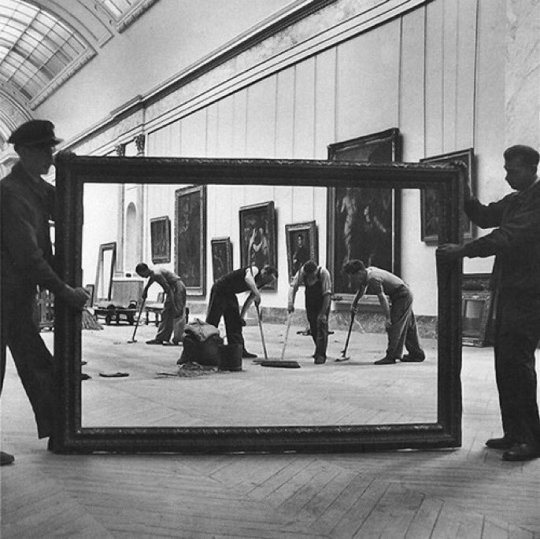
Pierre Jahan (September 9, 1909 – February 21, 2003), Workers at the Louvre, Paris, 1947
790 notes
·
View notes
Text
(A while ago @apurpledust mentioned wanting to know more about Duroc's children, so here's what information I have)
Duroc and his wife, Maria de las Nieves Martínez de Hervas, had two children, both of whom died tragically young. (Hervas left instructions that her gravestone should be engraved with "To the unhappiest of mothers".)
Their first child, Napoléon Louis Sidoine Joseph Duroc, was born on 24 February 1811 in Paris. Named for the emperor and his two grandfathers (Claude Sidoine de Michel du Roc and José Martínez de Hervas), he lived for just over fourteen months. The infant’s health was never good; Duroc wrote to Bertrand in March 1812 that “[Hervas] is doing well but her son has been and always is ill”. (As Duroc’s biographer Danielle Meyrueix notes, when writing of his wife and child he habitually referred to “her son” rather than “our son”. Perhaps not the most engaged of fathers.) Napoléon died on 6 May 1812 at Maidières in Lorraine. The architect Pierre Fontaine, noting in his journal that Hervas had asked him to design a tomb for her lost son, wrote that the child had been “a few days older than the King of Rome and destined to enjoy at that prince’s side all the favor with which the Emperor honored his father.”
Their daughter Hortense Eugénie Nieves Duroc was born on 14 May 1812, eight days after the young Napoléon’s death. (In a letter, Duroc implied that the news of the boy’s death had been kept from Hervas, who was in Paris, to avoid imperiling her health.) Named for her godmother, Hortense de Beauharnais, she was baptized in January 1813 alongside the duke of Bassano's daughter. After Duroc’s death in May 1813, Napoleon transferred the duchy of Friuli to her, writing to Hervas that Hortense would be “assured of my constant protection”. He also remembered her in his will, leaving her a large sum of money and recommending, in one last attempt at matchmaking, that she marry Bessières’s son, the duke of Istria. Hortense’s aunt wrote in 1823 that “Hortense is perfectly sweet, she’s a rare child for her spirit and intelligence, who her poor father would have been happy to see so fine in all respects”. She died of pneumonia on 24 September 1829 after three days of illness, aged seventeen.

A 1933 biography of Charles-Nicolas Fabvier (Hervas’s second husband) identifies this painting by Jeanne-Elisabeth Chaudet as a young Hortense Duroc. It was sold at an auction a few years ago with the title “Young Embroideress”, so either the sitter’s identity has been lost since then or it may never have been Hortense at all.
Duroc’s long liaison with the dancer Emilie Bigottini may also have resulted in at least one child. Felix Bouvier, writing a biographical sketch of Bigottini in 1909, claimed that “children were born of this irregular union, a daughter and a son named Odilon”. However, Odilon (full name Pierre Dominique Jean Marie Odilon Michel du Roc), born in 1801, was the son of Duroc’s cousin Géraud Pierre Michel du Roc, the marquis de Brion. On Duroc’s death, Napoleon made Odilon a page in the imperial household. (This may have given rise to Bouvier’s claim, as it seems to have confused people at the time. Caulaincourt had been tasked with sorting out Duroc’s affairs, including a substantial amount of money for Bigottini, and Duroc’s sister Jeanne implied that he had gotten the wrong impression from one of Duroc’s requests: “On the subject of the allowance for little Odilon, M. the duke of Vicenza was misled…he took a step which pained me very much”.) As for the daughter, all I’ve been able to find so far is a remark from Laure Junot that “It was known that the count Armand de Fuentès had had a daughter with Mademoiselle Bigottini, and that Duroc was in the same position”.
46 notes
·
View notes
Text
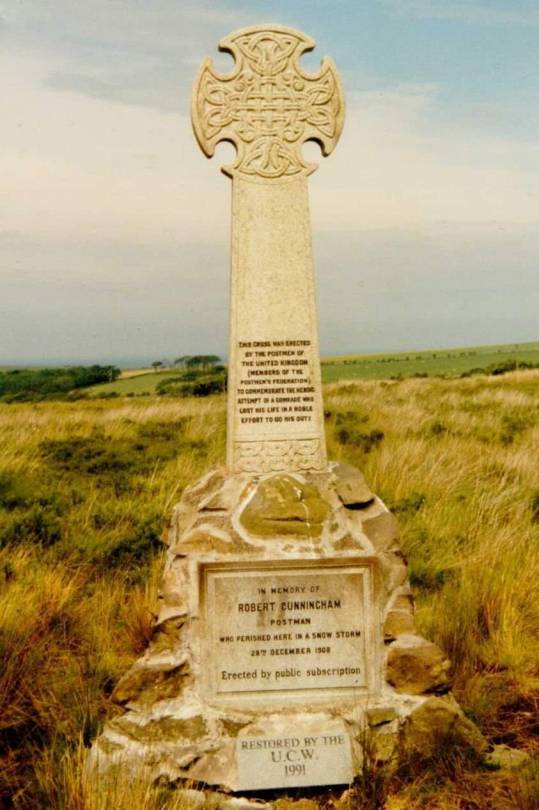
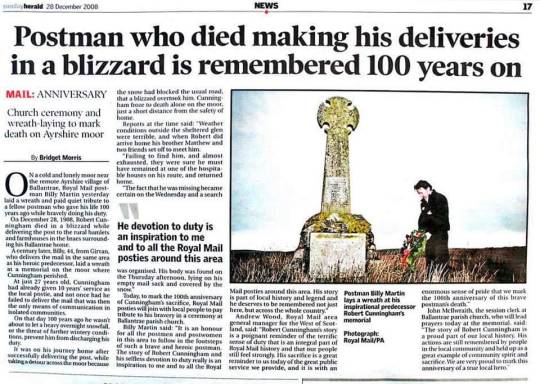
On December 28th 1908 Postman Robert Cunningham set off in blizzard conditions from Ballantrae to deliver the mail to the Glenapp residents. less than 2 miles away.
After two days when he had not returned a search party was organised, his body was found lying on his mail sack and covered by the snow.
In 1909 a monument was erected on the A77 between Stranraer and Ballantrae at Carlock Hill by postmen from around the country to commemorate the heroic attempt of a comrade. The inscription on the Cairn reads "In memory of Robert Cunningham, Postman who perished here in a snowstorm 28th December 1908. Erected by public Subscription.
In 1991 the Memorial was restored by the Union of Communications Workers and rededicated on 20th. September 1992.
57 notes
·
View notes
Text

"Sarah Hannah Jones was buried there after she died on September 5, 1909. There, behind St. Peter’s Church, among the markers on the grassy hill that slopes down into one of the main cargo routes to Ireland, a Celtic cross designates her gravesite. It features the curious inscription 'POET PHILOSOPHER & FAILURE.'
There is little explanation to be found about the cryptic words. The church was consecrated in 967, and the oldest parts of the physical building date back to the 8th century. Sarah’s husband, James, remarried another woman named Sarah. She died in 1929, and a year after James followed. All three are buried in the spot, their stones stacked under Sarah Hannah’s cross. James’ inscription is strange but a little less mysterious: 'ALAS POOR YORICK.'"
- via Atlas Obscura
#atlas obscura#dark academi#poet#philosopher#failure#literature#english literature#romanticism#history#poetry#writing#dark aesthetic#dark academia#goth#cemetery#graves#funeral#graveyard#tombstones#funny#morbid
36 notes
·
View notes
Text

1909 (September) Les Modes - Robe de promenade par Laferrière - photo by Henri Manuel. From gallica.bnf.fr; fixed spots & flaws w Pshop & fixed mono-color tint 1481X2028.
#1908 fashion#1900s fashion#Belle Époque fashion#Edwardian fashion#promenade dress#clerical neckline#draped bodice#three-quarter length sleeves#close skirt
38 notes
·
View notes
Text

La Mode illustrée, no. 38, 19 septembre 1909, Paris. Robe d'après-midi, de Hélène Bion. Doc. phot. Manuel. Ville de Paris / Bibliothèque Forney
Description de la gravure coloriée:
La robe, de forme princesse, est faite en taffetas violet; la tunique drapée est ornée de broderie en soutache assortie, et bordée par une haute frange en soie; on la garnit en outre avec des motifs de passementerie. Le corsage, également brodé, est complété par une guimpe à manches longues en dentelle.
The princess-shaped dress is made of purple taffeta; the draped tunic is decorated with matching soutache embroidery, and bordered by a high silk fringe; it is also garnished with trimmings patterns. The bodice, also embroidered, is completed by a long-sleeved lace wimple.
#La Mode illustrée#20th century#1900s#1909#on this day#September 19#periodical#fashion#fashion plate#cover#color#cover redo#description#Forney#dress#princess#Bion#Manuel#photo
42 notes
·
View notes
Text
Happy Birthday to Le Fantôme de l’Opéra
It’s that time of year again, when we give birthday wishes to Le Fantôme de l’Opéra! On Thursday, 23 September, 1909, the first section of Gaston Leroux’s novel was printed in the Parisian daily newspaper, Le Gaulois. Phantom has now been in print for 114 years!
Follow along for the next 15 weeks as we celebrate the 114th year of Phantom in print by experiencing the 68 sections of Le Fantôme de l’Opéra as they first appeared in the feuilleton section of Le Gaulois.
As you will see, there are major changes that Leroux and his editors made between the feuilleton version of Le Fantôme in Le Gaulois and the 1910 first edition, including the deletion of an entire chapter, called “The Magic Envelope,” for which I created the first known English translation, which you can read here.
#phantom of the opera#gaston leroux#poto#le gaulois#le fantôme de l’opéra#this is a day late but better late than never!#yom kippur has been taking up the brain space#g'mar chatima tova to all jewish phans#15 weeks of phantom
67 notes
·
View notes
Text
"In St. Petersburg we work, but at Livadia, we live."
Grand Duchess Olga Alexandrovna
In 1909, Nikolay Krasnov, who was responsible for the Yousupoff Palace in Koreiz, was engaged to design a new imperial palace in Livadia (before that, there had been an imperial residence in Livadia consisting of a large and a small palace used by Alexander II and later by Alexander III, who died at the smaller residence.) When Nicholas II decided to build the new palace, he also demolished the older residence but left the small palace where his father died.
The Tsar's diary indicates that the Imperial Family discussed the design; it was decided that all four façades of the palace should look different. After 17 months of construction, the new palace was inaugurated on 11 September 1911. In November, Grand Duchess Olga Nikolaevna celebrated her 16th birthday at Livadia.
The family was always the happiest at Livadia.
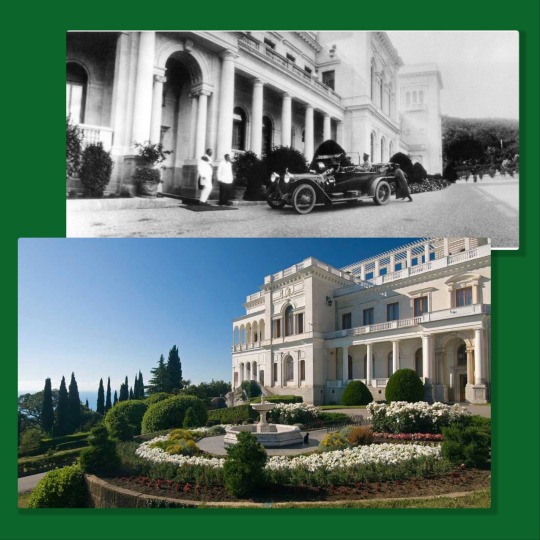
One of the Tsar's "motors" at Livadia. If you look carefully, you can see the "side of the palace" where the car is parked and the main entrance in both the contemporary colored and black and white photos.
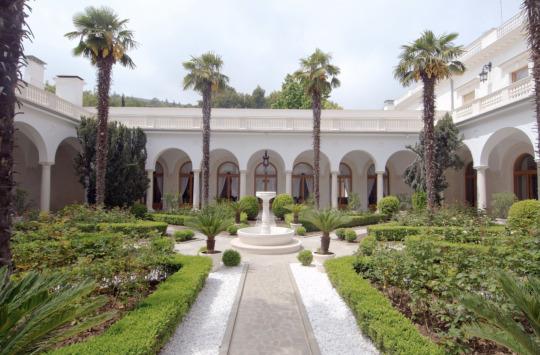
Above is the beautiful Italian Courtyard of the palace as it stands today. If you look at pictures taken when the Romanovs used the palace, the centerpiece of the courtyard was different. Today, there is a fountain at the center. Examining the older pictures (below), you can see that there seemed to be what I can only describe as a "well" at the center of the courtyard. There was a column on each side of the well. In one of the photos below, you can see Grand Duke Dmitry Pavlovich; he had his own rooms at the Livadia Palace.
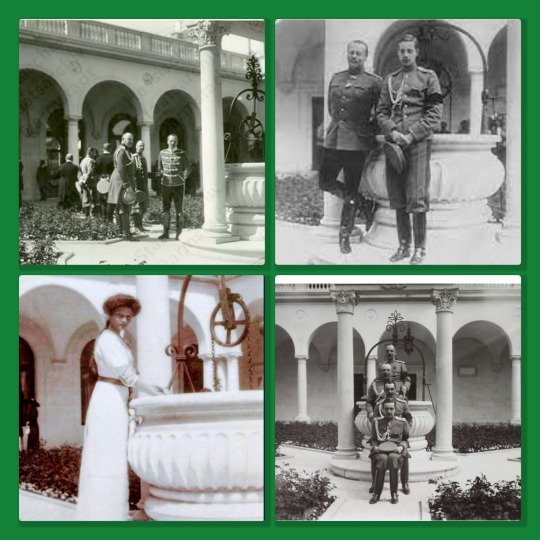
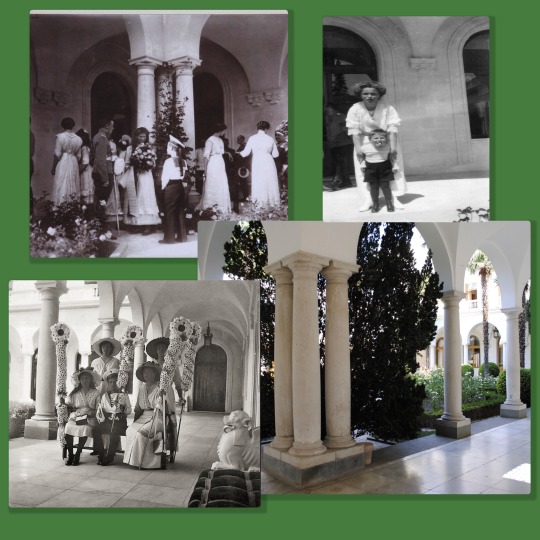
Nicholas II and his family were so at ease at Livadia that they also conducted some minor official functions in addition to family activities. When the family went to Livadia, they usually went as far as Yalta by sea; it is easy to infer that the official activities they conducted were related to the crew of the Standart. In addition, at the time, it was believed that mountain air and rest could cure tuberculosis, and there were several spas and sanatoria in the mountains in the area. The Empress and the girls visited the sick there (they also participated in other charitable activities.)



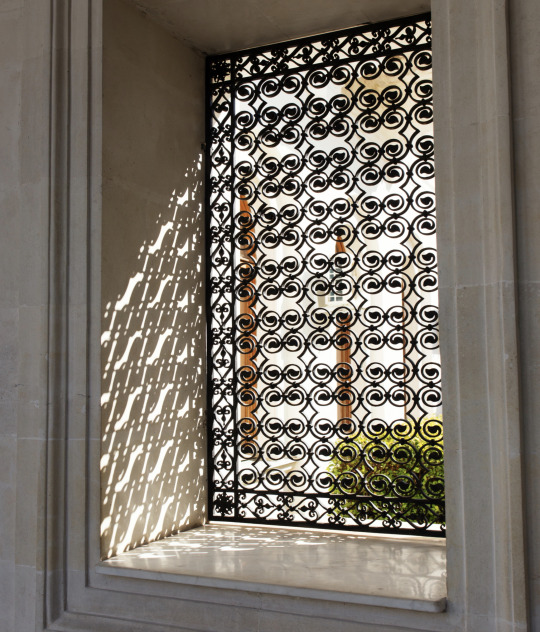
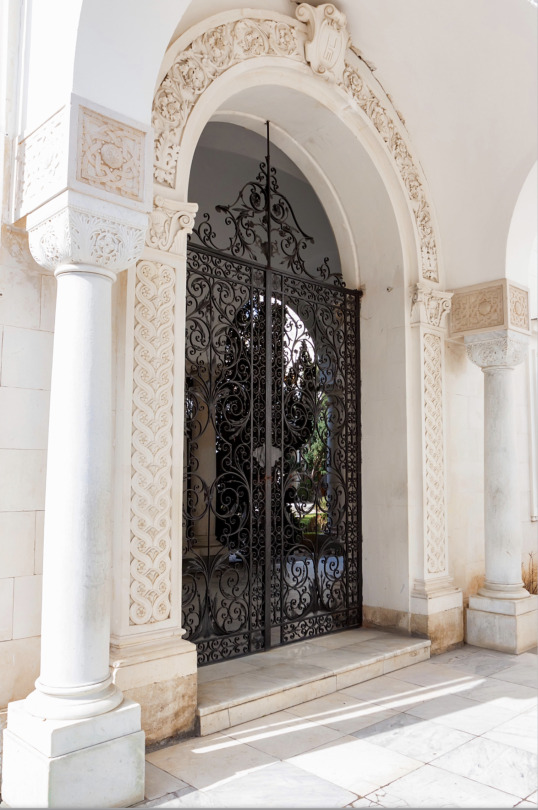
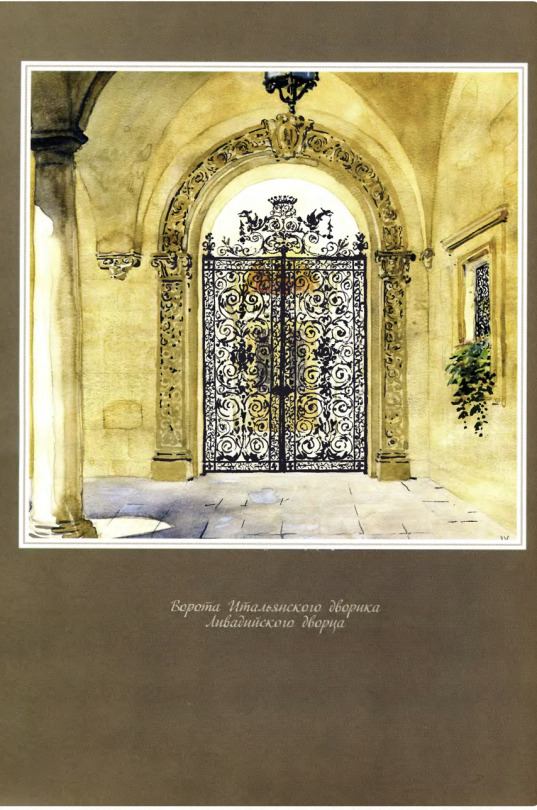
The Yousupov family gifted the beautiful door above to Nicholas and Alexandra. The painting next to it is from a beautiful book by Kravnov ("Fiftieth Anniversary of Yalta"), who worked on the palace's design (and on that of the Crimean summer residences of several Grand Dukes.) The window is also featured in the painting.
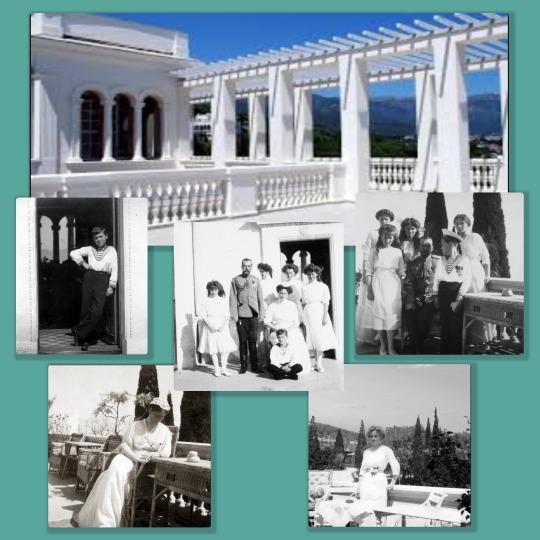
The "solarium" seems to have been a very popular area. Nicholas and his children preferred the outdoors, and Livadia seemed to provide the Empress with the perfect environment to get sun and fresh air in comfort regardless of her many ailments.

This is the "Moorish" courtyard of the palace. It is small, but notice the exquisite tilework on the walls. And, of course, the little balcony between the windows seemed perfect to Alexis for him to "address" his family.
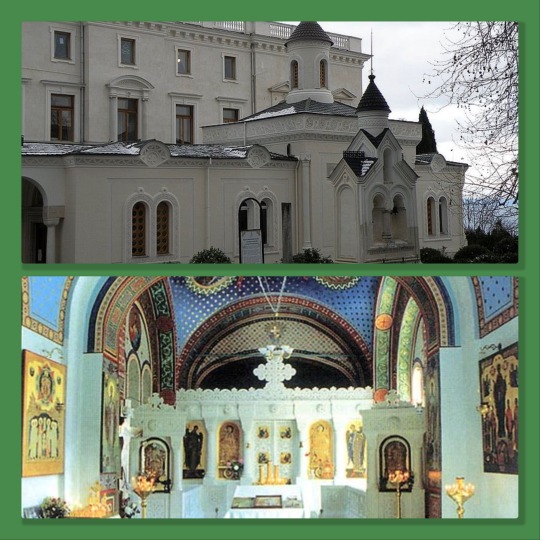
The palace had a chapel so that the Romanov family could worship in privacy.
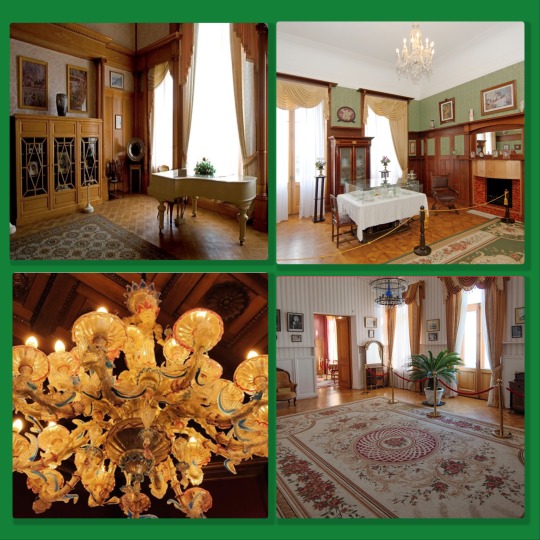

A few of the interiors of the palace. The chandelier is Murano Glass (amazing that it survived all these years.) Olga's coming-of-age celebration took place in Livadia in the formal dining room in the photograph above, dancing spilling into the flower-perfumed courtyard. That is a luxury of the type you cannot buy! The girls' rooms are currently being restored. There are pictures of the rooms as they were, but I was not sure they were from Livadia, so I did not include them.
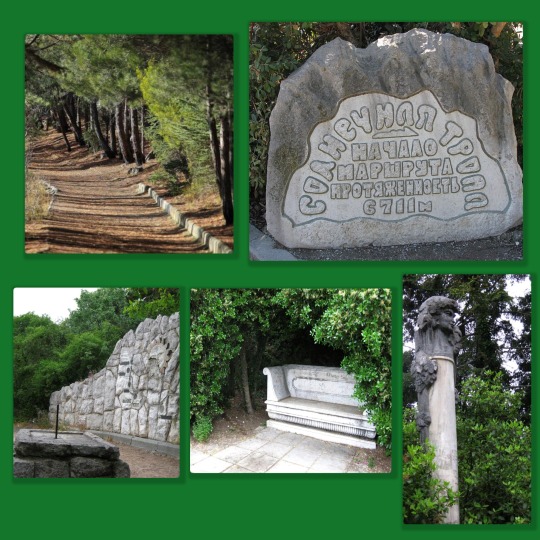

Finally, some photos of the "Tsar's Path" (or Sunny Path), which exists to this day (it goes from Livadia Park to the city of Gaspra.) The family loved to walk this path (regardless of its name, it is not sunny but pleasantly breezy). This path is on one level so that anybody can walk it, regardless of their cardiovascular status. I have read two stories about how it "emerged," and as usual, the truth is probably in the middle. First story: The new Livadia Palace did not exist yet, but the Romanovs used the old palace and always loved coming to Livadia. Alexander III kept gaining weight, and his doctor recommended that he walk but not overdo it...so Alexander had the path leveled. The path's beginning and end differed from what they would be later. Second Story: Sandro had the path from Ay Todor toward Livadia built because Nicholas and Sandro's families always visited each other (they started calling it the Prince's Path.) Nicholas loved the idea and extended the path.
Today, the main path remains, and other routes to other small towns can be hiked from it. Many of the same benches and sculptures are where they were at the time of the Romanovs.

Just one last photo. Here, you can see how close the palace is to the mountains and the sea. A beautiful big house full of fresh air and light with flowers perfuming the air. No wonder Olga liked it so much! (gcl)
#russian history#romanov dynasty#nicholas ii#otma#Empress Alexandra Feodorovna#Emperor Alexander III#Grand Duke Alexander Mikhailovich#Ay Todor#Nikolay Krasnov#grand duchess olga nicholayevna#Grand Duchess Tatiana Nicholayevna#Grand Duchess Maria Nicholayevna#Grand Duchess Anastasia Nicholayevna#Tsarevich Alexei
55 notes
·
View notes
Photo

Anders Beer Wilse - Helen Marie Wilse på stranden. Fotografert 6. september 1909
112 notes
·
View notes